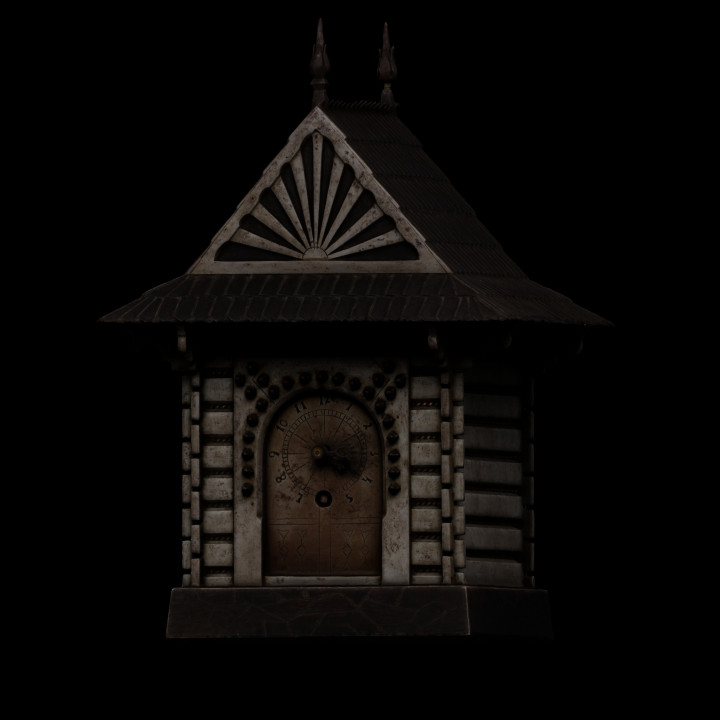
Clock shaped as a highlander's cottage
myminifactory
We buy, receive and collect... items of so-called everyday use that are faithful companions of our reality. We try to surround ourselves with objects that bring us pleasure, that cause our hearts to beat faster and that we take a liking to at the first glance. The space that surrounds us is important. We run away from “ordinariness” and “mediocrity”. We always try to decorate it somehow. The same applies to the past. In the 2nd half of the 19th century in England, artists who were dissatisfied with mass machine production started the Arts and Crafts Movement. They wanted to re-create what was beautiful and noble in everyday-use objects. This initiative reverberated throughout the whole of Europe, including also Poland of that time.In 1886 Stanisław Witkiewicz, painter, art critic and theoretician, came to Zakopane. After four years he settled in a small village at the foot of the Tatra Mountains and started a new style in architecture. Inspired by the folklore and art of Podhale, he created the Zakopane style which referred not only to construction but also to the furnishing of new houses. Similar to the above-mentioned English Arts and Crafts Movement, the Zakopane style was a holistic project encompassing every detail of art. Witkiewicz wanted his ideas and concepts to spread all over Poland that was, at that time, under the occupants' rule. The new Zakopane style was to be the first Polish national style that was pleasant to the eye and supported the national identity. The enforcement of these new assumptions advanced with different effects. However, some artists became interested in Witkiewicz's designs and tried to create other works in this spirit. These included, eg, the neighbor casket and the clock shaped as a highlander's cottage made by Jan Mosz in the 1 stdecade of the 20th century .Witkiewicz thought that the folk art of Podhale was an abundant source of inspiration for designers. He obviously did not mean copying the patterns without questioning, but approaching what could be found in the highlander's cottages in a creative way. A whole number of items “without which the life of contemporary people could not go on” must have been invented by those who accepted the challenge of the Zakopane style. They included a casket for valuable belongings and a small clock to be placed on a desk or table. Their shapes actually drew upon the repertoire of folk shapes.The shape of the jewelery casket is derived from neighbors that could be found in nearly every highlander's cottage. They were chests of typical carpentry structure reminiscent of the “post” joint used in wooden architecture. The basic structural elements were four massive posts acting as legs and vertical edges of the chest. Two thick slats were let in the posts with a number of embedded vertical planks shaped and joint similar to shingles. The chest lid was flat. They were made of durable hard hood that was joined with wooden pegs. They were used to store various objects in the room, including corn. In the smaller and more ornate chests one could find “holy herbs”. In case of this casket, the author used an object that was intended for storage purposes but reduced its size. He also used a different material, namely steel.The clock was inspired by the entire highlander cottage with the horst structure and bonnet roof covered with shingles and crowned with decorative pazdur. The face was located in the door embedded in a rich frame hammered in with pegs. The mechanism was hidden inside. Just like in a house the heart beat inside. This form was a kind of advertisement for Podhale architecture. When looking at the metal miniature, one's memory goes back to the wooden originals in Tatra villages – it happens every time one's eyes rest on the face to check the time.It is said that architecture is the art closest to man. The objects used by man every day are definitely even closer. Those inconspicuous companions of everyday life witness our every move, our joys and sorrows. We move among them, touch them briefly, sometimes look at them without noticing them, but we know their shape and every ornament by heart and we are not indifferent to them. We have our favorite cups, spoons and vases. We carefully select a friend who will measure our hours. It is no wonder that, after years of service, they find safe shelter in museum exhibitions. When watching them, remember about those whom they accompanied...
With this file you will be able to print Clock shaped as a highlander's cottage with your 3D printer. Click on the button and save the file on your computer to work, edit or customize your design. You can also find more 3D designs for printers on Clock shaped as a highlander's cottage.
